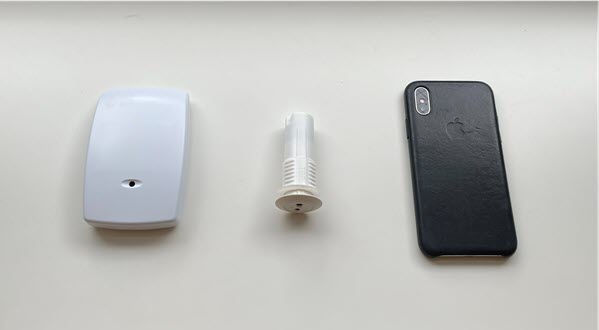Installing Glass Break Sensors Can be Tricky: Here’s What You Need to Know.
John Kolb is Director of Technical Sales at DGA Security, where he provides advanced technical support to DGA customers and evaluates emerging security technologies. A 43-year industry veteran, John holds a Certified Engineering Technologist (CET) status from NICET and a Certified Protection Professional (CPP) status from ASIS International, the gold standard certification for security management professionals.
Modern electronic glass break sensors are smart devices that are highly effective at detecting a breaking glass window. But the truth is glass break sensors can be tricky in a business security alarm system. High-pitched noises from outside can cause false alarms. Furthermore, some glass window types don’t shatter in a way that can be picked up reliably by these sensors.
If you’re wondering whether you should add glass break sensors to your business security system, read this article to understand how they work, and weigh the pros and cons. While you should always consult with an experienced business security professional to design a proper intrusion system, you’ll be armed with the right questions to ask before installing glass break sensors.
What is the Role of Glass Break Sensors in a Business Security System?
Glass break sensors are audio sensors that trigger an alarm when they detect the sound of glass being shattered. They are especially popular among businesses that showcase high-value merchandise in a window display such as jewelry stores, luxury retailers and art galleries, which tend to attract “smash and grab” style break-ins. For these types of businesses, their business insurance provider would likely require glass break sensors as part of their comprehensive business security system.
Remember, these sensors can’t prevent a criminal from breaking the glass window. But they can be very useful in deterring further looting after a window break-in by drawing attention with a loud alarm and alerting the incident to the monitoring center to contact the local authorities for immediate assistance.
While useful, glass break sensors should not be considered as the primary protection in a business security alarm system for a few good reasons. First, not all intrusions involve breaking a glass window. If no glass is broken during an intrusion, the glass break sensors can’t detect the break-in. Second, glass break sensors are not 100% foolproof. Factors such as the glass thickness and construction, or noise-dampening materials inside the business can prevent glass break sensors from operating reliably.
For these critical reasons, glass break sensors should only be used as supplementary protection to a well-designed business security system.
How Do Glass Break Sensors Work?
Glass break sensors utilize built-in audio recognition technology to “listen” for sound patterns and frequencies of breaking glass. As soon as a sensor detects a matching sound frequency, it initiates the security alarm.
Glass break sensors are installed within 25 feet from the target windows in a clear line of sight. In order to provide ample protection, we always recommend installing multiple glass break sensors to cover the target window area to ensure that the alarm event will be detected.
As soon as a sensor detects breaking glass, the alarm signal is instantly reported to the monitoring center, and local authorities will be alerted and dispatched. The monitoring center will also notify the emergency contacts associated with the business location. The pattern and timing of alarm signals received from different security devices during a break-in can help piece together a detailed depiction of the intrusion event.
Types of Glass Break Sensors
The Standard Glass Break Sensor we use is a small, rectangle-shaped device that can be easily attached to any ceiling or wall. For clients who are looking for an even more discreet look, we recommend the smaller Recessed Glass Break Sensor that can be flush-mounted directly into the wall or ceiling for a seamless look.
Glass break sensors also come in models that can be attached directly to the glass window but they are rarely used because they will need to be replaced whenever the glass breaks.
 From left: Standard Glass Break Sensor, Recessed Glass Break Sensor, and an iPhone for size reference
From left: Standard Glass Break Sensor, Recessed Glass Break Sensor, and an iPhone for size reference
Should You Get Glass Break Sensors for Your Business Security Alarm System? Consider These Critical Factors.
If you are considering adding glass break sensors to your business security alarm system, here are some important factors to keep in mind:
- Consider the high-pitched noises in your surroundings: High-pitched noises that are common in many commercial zones, such as screeching tires, diesel engines or garbage trucks, can trigger a false alarm. False alarms can be troublesome and costly so consider the ambient noises surrounding the target glass window area.
- Glass break sensors don’t work for all types of glass: The thickness, construction, and coating of the glass can interfere with a glass break sensor’s ability to function properly. Plate glass is easiest for glass break sensors to detect. Laminated or safety glass that has plastic or wire inside don’t work well with glass break sensors since they don’t shatter and therefore won’t emit the sound frequency that can be detected by the sensors.
- Do you have noise-dampening materials?: The presence of heavy fabrics (e.g., curtains, carpeting) and other sound-dampening surfaces can interfere with a glass sensor’s ability to pick up the audio input.
- Always install more glass break sensors than the minimum specified: Considering the many factors that may interfere with a glass break sensor’s effectiveness, always install more than the minimum number of glass break sensors specified to cover the target window area. For example, a 75-foot long window specifies 3 glass break sensors since each glass break sensor covers a 25-foot radius. But we recommend installing at least 5 or more break sensors to cover a 75-foot long window to ensure reliable protection.
Still have questions about glass break sensors?
Every business has a unique set of business security challenges. Submit your question using our online form or call us at 800 PICK DGA (800-742-5342) to speak with one of DGA’s experienced business security experts.
See related articles about business intrusion alarm systems:
Why are motion sensors necessary in business security systems?
Should your business security systems provider have a SOC audit?




